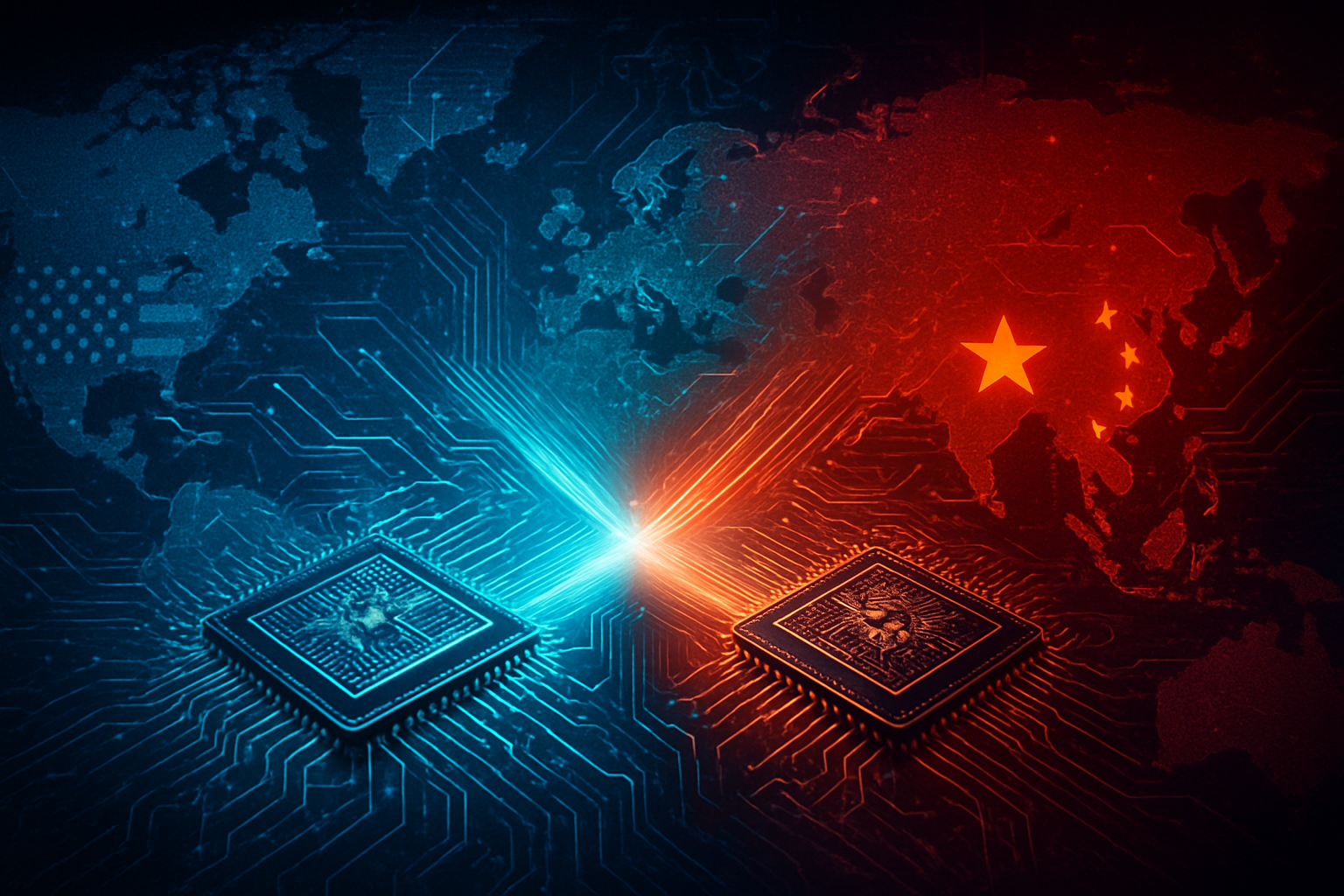The United States has dramatically escalated its export restrictions on advanced Artificial Intelligence (AI) chips, explicitly barring Nvidia's (NASDAQ: NVDA) cutting-edge Blackwell series, including even specially designed, toned-down variants, from the Chinese market. This decisive move marks a significant tightening of existing controls, underscoring a strategic shift where national security and technological leadership take precedence over free trade, and setting the stage for an irreversible bifurcation of the global AI ecosystem. The immediate significance is a profound reordering of the competitive dynamics in the AI industry, forcing both American and Chinese tech giants to recalibrate their strategies in a rapidly fragmenting world.
This latest prohibition, which extends to Nvidia's B30A chip—a scaled-down Blackwell variant reportedly developed to comply with previous US regulations—signals Washington's unwavering resolve to impede China's access to the most powerful AI hardware. Nvidia CEO Jensen Huang has acknowledged the gravity of the situation, confirming that there are "no active discussions" to sell the advanced Blackwell AI chips to China and that the company is "not currently planning to ship anything to China." This development not only curtails Nvidia's access to a historically lucrative market but also compels China to accelerate its pursuit of indigenous AI capabilities, intensifying the technological rivalry between the two global superpowers.
Blackwell: The Crown Jewel Under Lock and Key
Nvidia's Blackwell architecture, named after the pioneering mathematician David Harold Blackwell, represents an unprecedented leap in AI chip technology, succeeding the formidable Hopper generation. Designed as the "engine of the new industrial revolution," Blackwell is engineered to power the next era of generative AI and accelerated computing, boasting features that dramatically enhance performance, efficiency, and scalability for the most demanding AI workloads.
At its core, a Blackwell processor (e.g., the B200 chip) integrates a staggering 208 billion transistors, more than 2.5 times the 80 billion found in Nvidia's Hopper GPUs. Manufactured using a custom-designed 4NP TSMC process, each Blackwell product features two dies connected via a high-speed 10 terabit-per-second (Tb/s) chip-to-chip interconnect, allowing them to function as a single, fully cache-coherent GPU. These chips are equipped with up to 192 GB of HBM3e memory, delivering up to 8 TB/s of bandwidth. The flagship GB200 Grace Blackwell Superchip, combining two Blackwell GPUs and one Grace CPU, can boast a total of 896GB of unified memory.
In terms of raw performance, the B200 delivers up to 20 petaFLOPS (PFLOPS) of FP4 AI compute, approximately 10 PFLOPS for FP8/FP6 Tensor Core operations, and roughly 5 PFLOPS for FP16/BF16. The GB200 NVL72 system, a rack-scale, liquid-cooled supercomputer integrating 36 Grace Blackwell Superchips (72 B200 GPUs and 36 Grace CPUs), can achieve an astonishing 1.44 exaFLOPS (FP4) and 5,760 TFLOPS (FP32), effectively acting as a single, massive GPU. Blackwell also introduces a fifth-generation NVLink that boosts data transfer across up to 576 GPUs, providing 1.8 TB/s of bidirectional bandwidth per GPU, and a second-generation Transformer Engine optimized for LLM training and inference with support for new precisions like FP4.
The US export restrictions are technically stringent, focusing on a "performance density" measure to prevent workarounds. While initial rules targeted chips exceeding 300 teraflops, newer regulations use a Total Processing Performance (TPP) metric. Blackwell chips, with their unprecedented power, comfortably exceed these thresholds, leading to an outright ban on their top-tier variants for China. Even Nvidia's attempts to create downgraded versions like the B30A, which would still be significantly more powerful than previously approved chips like the H20 (potentially 12 times more powerful and exceeding current thresholds by over 18 times), have been blocked. This technically limits China's ability to acquire the hardware necessary for training and deploying frontier AI models at the scale and efficiency that Blackwell offers, directly impacting their capacity to compete at the cutting edge of AI development.
Initial reactions from the AI research community and industry experts have been a mix of excitement over Blackwell's capabilities and concern over the geopolitical implications. Experts recognize Blackwell as a revolutionary leap, crucial for advancing generative AI, but they also acknowledge that the restrictions will profoundly impact China's ambitious AI development programs, forcing a rapid recalibration towards indigenous solutions and potentially creating a bifurcated global AI ecosystem.
Shifting Sands: Impact on AI Companies and Tech Giants
The US export restrictions have unleashed a seismic shift across the global AI industry, creating clear winners and losers, and forcing strategic re-evaluations for tech giants and startups alike.
Nvidia (NASDAQ: NVDA), despite its technological prowess, faces significant headwinds in what was once a critical market. Its advanced AI chip business in China has reportedly plummeted from an estimated 95% market share in 2022 to "nearly zero." The outright ban on Blackwell, including its toned-down B30A variant, means a substantial loss of revenue and market presence. Nvidia CEO Jensen Huang has expressed concerns that these restrictions ultimately harm the American economy and could inadvertently accelerate China's AI development. In response, Nvidia is not only redesigning its B30A chip to meet potential future US export conditions but is also actively exploring and pivoting to other markets, such as India, for growth opportunities.
On the American side, other major AI companies and tech giants like Microsoft (NASDAQ: MSFT), Meta Platforms (NASDAQ: META), and OpenAI generally stand to benefit from these restrictions. With China largely cut off from Nvidia's most advanced chips, these US entities gain reserved access to the cutting-edge Blackwell series, enabling them to build more powerful AI data centers and maintain a significant computational advantage in AI development. This preferential access solidifies the US's lead in AI computing power, although some US companies, including Oracle (NYSE: ORCL), have voiced concerns that overly stringent controls could, in the long term, reduce the global competitiveness of American chip manufacturers by shrinking their overall market.
In China, AI companies and tech giants are facing profound challenges. Lacking access to state-of-the-art Nvidia chips, they are compelled to either rely on older, less powerful hardware or significantly accelerate their efforts to develop domestic alternatives. This could lead to a "3-5 year lag" in AI performance compared to their US counterparts, impacting their ability to train and deploy advanced generative AI models crucial for cloud services and autonomous driving.
- Alibaba (NYSE: BABA) is aggressively developing its own AI chips, particularly for inference tasks, investing over $53 billion into its AI and cloud infrastructure to achieve self-sufficiency. Its domestically produced chips are reportedly beginning to rival Nvidia's H20 in training efficiency for certain tasks.
- Tencent (HKG: 0700) claims to have a substantial inventory of AI chips and is focusing on software optimization to maximize performance from existing hardware. They are also exploring smaller AI models and diversifying cloud services to include CPU-based computing to lessen GPU dependence.
- Baidu (NASDAQ: BIDU) is emphasizing its "full-stack" AI capabilities, optimizing its models, and piloting its Kunlun P800 chip for training newer versions of its Ernie large language model.
- Huawei (SHE: 002502), despite significant setbacks from US sanctions that have pushed its AI chip development to older 7nm process technology, is positioning its Ascend series as a direct challenger. Its Ascend 910C is reported to deliver 60-70% of the H100's performance, with the upcoming 910D expected to narrow this gap further. Huawei is projected to ship around 700,000 Ascend AI processors in 2025.
The Chinese government is actively bolstering its domestic semiconductor industry with massive power subsidies for data centers utilizing domestically produced AI processors, aiming to offset the higher energy consumption of Chinese-made chips. This strategic pivot is driving a "bifurcation" in the global AI ecosystem, with two partially interoperable worlds emerging: one led by Nvidia and the other by Huawei. Chinese AI labs are innovating around hardware limitations, producing efficient, open-source models that are increasingly competitive with Western ones, and optimizing models for domestic hardware.
For startups, US AI startups benefit from uninterrupted access to leading-edge Nvidia chips, potentially giving them a hardware advantage. Conversely, Chinese AI startups face challenges in acquiring advanced hardware, with regulators encouraging reliance on domestic solutions to foster self-reliance. This push creates both a hurdle and an opportunity, forcing innovation within a constrained hardware environment but also potentially fostering a stronger domestic ecosystem.
A New Cold War for AI: Wider Significance
The US export restrictions on Nvidia's Blackwell chips are far more than a commercial dispute; they represent a defining moment in the history of artificial intelligence and global technological trends. This move is a strategic effort by the U.S. to cement its lead in AI technology and prevent China from leveraging advanced AI processors for military and surveillance capabilities, solidifying a global trend where AI is seen as critical for national security, economic leadership, and future innovation.
This policy fits into a global trend where nations view AI as critical for national security, economic leadership, and future technological innovation. The Blackwell architecture represents the pinnacle of current AI chip technology, designed to power the next generation of generative AI and large language models (LLMs), making its restriction particularly impactful. China, in response, has accelerated its efforts to achieve self-sufficiency in AI chip development. Beijing has mandated that all new state-funded data center projects use only domestically produced AI chips, a directive aimed at eliminating reliance on foreign technology in critical infrastructure. This push for indigenous innovation is already leading to a shift where Chinese AI models are being optimized for domestic chip architectures, such as Huawei's Ascend and Cambricon.
The geopolitical impacts are profound. The restrictions mark an "irreversible phase" in the "AI war," fundamentally altering how AI innovation will occur globally. This technological decoupling is expected to lead to a bifurcated global AI ecosystem, splitting along U.S.-China lines by 2026. This emerging landscape will likely feature two distinct technological spheres of influence, each with its own companies, standards, and supply chains. Countries will face pressure to align with either the U.S.-led or China-led AI governance frameworks, potentially fragmenting global technology development and complicating international collaboration. While the U.S. aims to preserve its leadership, concerns exist about potential retaliatory measures from China and the broader impact on international relations.
The long-term implications for innovation and competition are multifaceted. While designed to slow China's progress, these controls act as a powerful impetus for China to redouble its indigenous chip design and manufacturing efforts. This could lead to the emergence of robust domestic alternatives in hardware, software, and AI training regimes, potentially making future market re-entry for U.S. companies more challenging. Some experts warn that by attempting to stifle competition, the U.S. risks undermining its own technological advantage, as American chip manufacturers may become less competitive due to shrinking global market share. Conversely, the chip scarcity in China has incentivized innovation in compute efficiency and the development of open-source AI models, potentially accelerating China's own technological advancements.
The current U.S.-China tech rivalry draws comparisons to Cold War-era technological bifurcation, particularly the Coordinating Committee for Multilateral Export Controls (CoCom) regime that denied the Soviet bloc access to cutting-edge technology. This historical precedent suggests that technological decoupling can lead to parallel innovation tracks, albeit with potentially higher economic costs in a more interconnected global economy. This "tech war" now encompasses a much broader range of advanced technologies, including semiconductors, AI, and robotics, reflecting a fundamental competition for technological dominance in foundational 21st-century technologies.
The Road Ahead: Future Developments in a Fragmented AI World
The future developments concerning US export restrictions on Nvidia's Blackwell AI chips for China are expected to be characterized by increasing technological decoupling and an intensified race for AI supremacy, with both nations solidifying their respective positions.
In the near term, the US government has unequivocally reaffirmed and intensified its ban on the export of Nvidia's Blackwell series chips to China. This prohibition extends to even scaled-down variants like the B30A, with federal agencies advised not to issue export licenses. Nvidia CEO Jensen Huang has confirmed the absence of active discussions for high-end Blackwell shipments to China. In parallel, China has retaliated by mandating that all new state-funded data center projects must exclusively use domestically produced AI chips, requiring existing projects to remove foreign components. This "hard turn" in US tech policy prioritizes national security and technological leadership, forcing Chinese AI companies to rely on older hardware or rapidly accelerate indigenous alternatives, potentially leading to a "3-5 year lag" in AI performance.
Long-term, these restrictions are expected to accelerate China's ambition for complete self-sufficiency in advanced semiconductor manufacturing. Billions will likely be poured into research and development, foundry expansion, and talent acquisition within China to close the technological gap over the next decade. This could lead to the emergence of formidable Chinese competitors in the AI chip space. The geopolitical pressures on semiconductor supply chains will intensify, leading to continued aggressive investment in domestic chip manufacturing capabilities across the US, EU, Japan, and China, with significant government subsidies and R&D initiatives. The global AI landscape is likely to become increasingly bifurcated, with two parallel AI ecosystems emerging: one led by the US and its allies, and another by China and its partners.
Nvidia's Blackwell chips are designed for highly demanding AI workloads, including training and running large language models (LLMs), generative AI systems, scientific simulations, and data analytics. For China, denied access to these cutting-edge chips, the focus will shift. Chinese AI companies will intensify efforts to optimize existing, less powerful hardware and invest heavily in domestic chip design. This could lead to a surge in demand for older-generation chips or a rapid acceleration in the development of custom AI accelerators tailored to specific Chinese applications. Chinese companies are already adopting innovative approaches, such as reinforcement learning and Mixture of Experts (MoE) architectures, to optimize computational resources and achieve high performance with lower computational costs on less advanced hardware.
Challenges for US entities include maintaining market share and revenue in the face of losing a significant market, while also balancing innovation with export compliance. The US also faces challenges in preventing circumvention of its rules. For Chinese entities, the most acute challenge is the denial of access to state-of-the-art chips, leading to a potential lag in AI performance. They also face challenges in scaling domestic production and overcoming technological lags in their indigenous solutions.
Experts predict that the global AI chip war will deepen, with continued US tightening of export controls and accelerated Chinese self-reliance. China will undoubtedly pour billions into R&D and manufacturing to achieve technological independence, fostering the growth of domestic alternatives like Huawei's (SHE: 002502) Ascend series and Baidu's (NASDAQ: BIDU) Kunlun chips. Chinese companies will also intensify their focus on software-level optimizations and model compression to "do more with less." The long-term trajectory points toward a fragmented technological future with two parallel AI systems, forcing countries and companies globally to adapt.
The trajectory of AI development in the US aims to maintain its commanding lead, fueled by robust private investment, advanced chip design, and a strong talent pool. The US strategy involves safeguarding its AI lead, securing national security, and maintaining technological dominance. China, despite US restrictions, remains resilient. Beijing's ambitious roadmap to dominate AI by 2030 and its focus on "independent and controllable" AI are driving significant progress. While export controls act as "speed bumps," China's strong state backing, vast domestic market, and demonstrated resilience ensure continued progress, potentially allowing it to lead in AI application even while playing catch-up in hardware.
A Defining Moment: Comprehensive Wrap-up
The US export restrictions on Nvidia's Blackwell AI chips for China represent a defining moment in the history of artificial intelligence and global technology. This aggressive stance by the US government, aimed at curbing China's technological advancements and maintaining American leadership, has irrevocably altered the geopolitical landscape, the trajectory of AI development in both regions, and the strategic calculus for companies like Nvidia.
Key Takeaways: The geopolitical implications are profound, marking an escalation of the US-China tech rivalry into a full-blown "AI war." The US seeks to safeguard its national security by denying China access to the "crown jewel" of AI innovation, while China is doubling down on its quest for technological self-sufficiency, mandating the exclusive use of domestic AI chips in state-funded data centers. This has created a bifurcated global AI ecosystem, with two distinct technological spheres emerging. The impact on AI development is a forced recalibration for Chinese companies, leading to a potential lag in performance but also accelerating indigenous innovation. Nvidia's strategy has been one of adaptation, attempting to create compliant "hobbled" chips for China, but even these are now being blocked, severely impacting its market share and revenue from the region.
Significance in AI History: This development is one of the sharpest export curbs yet on AI hardware, signifying a "hard turn" in US tech policy where national security and technological leadership take precedence over free trade. It underscores the strategic importance of AI as a determinant of global power, initiating an "AI arms race" where control over advanced chip design and production is a top national security priority for both the US and China. This will be remembered as a pivotal moment that accelerated the decoupling of global technology.
Long-Term Impact: The long-term impact will likely include accelerated domestic innovation and self-sufficiency in China's semiconductor industry, potentially leading to formidable Chinese competitors within the next decade. This will result in a more fragmented global tech industry with distinct supply chains and technological ecosystems for AI development. While the US aims to maintain its technological lead, there's a risk that overly aggressive measures could inadvertently strengthen China's resolve for independence and compel other nations to seek technology from Chinese sources. The traditional interdependence of the semiconductor industry is being challenged, highlighting a delicate balance between national security and the benefits of global collaboration for innovation.
What to Watch For: In the coming weeks and months, several critical aspects will unfold. We will closely monitor Nvidia's continued efforts to redesign chips for potential future US administration approval and the pace and scale of China's advancements in indigenous AI chip production. The strictness of China's enforcement of its domestic chip mandate and its actual impact on foreign chipmakers will be crucial. Further US policy evolution, potentially expanding restrictions or impacting older AI chip models, remains a key watchpoint. Lastly, observing the realignment of global supply chains and shifts in international AI research partnerships will provide insight into the lasting effects of this intensifying technological decoupling.
This content is intended for informational purposes only and represents analysis of current AI developments.
TokenRing AI delivers enterprise-grade solutions for multi-agent AI workflow orchestration, AI-powered development tools, and seamless remote collaboration platforms.
For more information, visit https://www.tokenring.ai/.








